Abstract
Wild-type Euglena gracillis cells synthesize the key chlorophyll precursor, δ-aminolevulinic acid (ALA), from glutamate in their plastids. The synthesis requires transfer RNAGlu (tRNAGlu) and the three enzymes, glutamyl-tRNA synthetase, glutamyl-tRNA reductase, and glutamate-1-semialdehyde aminotransferase. Non-greening mutant Euglena strain W14ZNaIL does not synthesize ALA from glutamate and is devoid of the required tRNAGlu. Other cellular tRNAGlus present in the mutant cells were capable of being charged with glutamate, but the resulting glutamyl-tRNAs did not support ALA synthesis. Surprisingly, the mutant cells contain all three of the enzymes, and their cell extracts can convert glutamate to ALA when supplemented with tRNAGlu obtained from wild-type cells. Activity levels of the three enzymes were measured in extracts of cells grown under a number of light conditions. All three activities were diminished in extracts of cells grown in complete darkness, and full induction of activity required 72 hours of growth in the light. A light intensity of 4 microeinsteins per square meter per second was sufficient for full induction. Blue light was as effective as white light, but red light was ineffective, in inducing extractable enzyme activity above that of cells grown in complete darkness, indicating that the light control operates via the nonchloroplast blue light receptor in the mutant cells. Of the three enzyme activities, the one that is most acutely affected by light is glutamate-1-semialdehyde aminotransferase, as has been previously shown for wild-type Euglena cells. These results indicate that the enzymes required for ALA synthesis from glutamate are present in an active form in the nongreening mutant cells, even though they cannot participate in ALA formation in these cells because of the absence of the required tRNAGlu, and that the activity of all three enzymes is regulated by light. Because the absence of plastid tRNAGlu precludes the synthesis of proteins within the plastids, the three enzymes must be synthesized in the cytoplasm and their genes encoded in the nucleus in Euglena.
Full text
PDF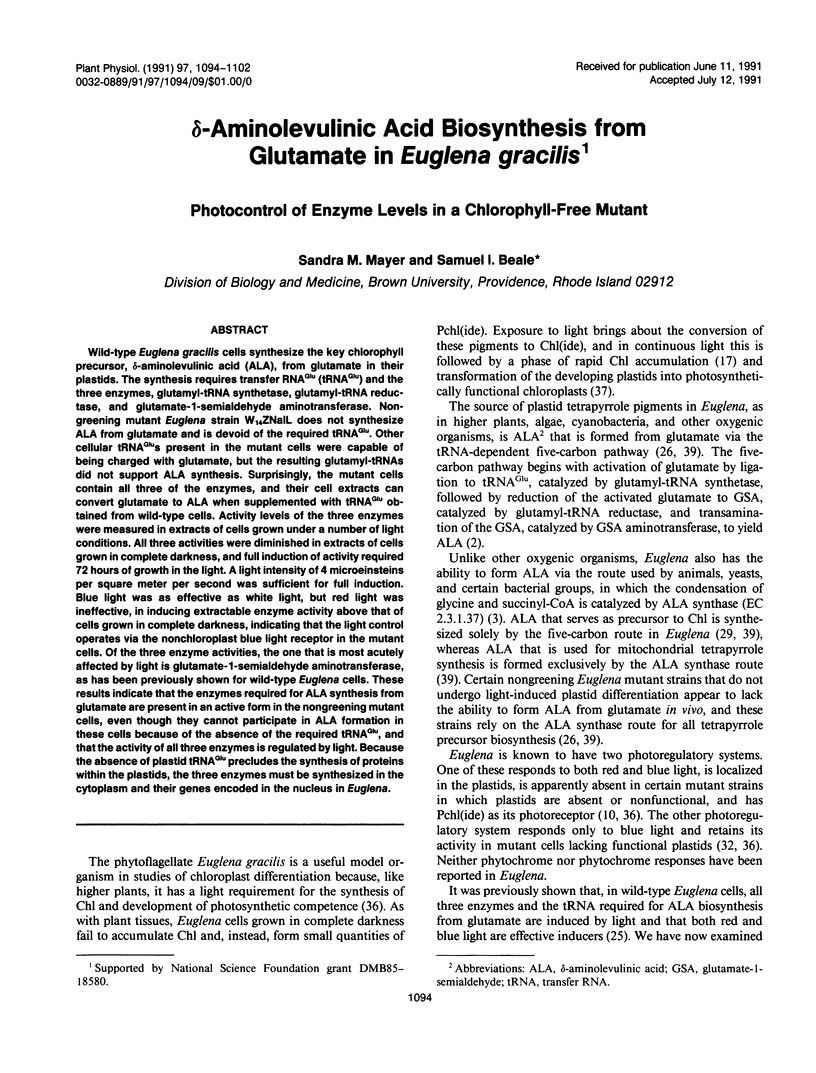
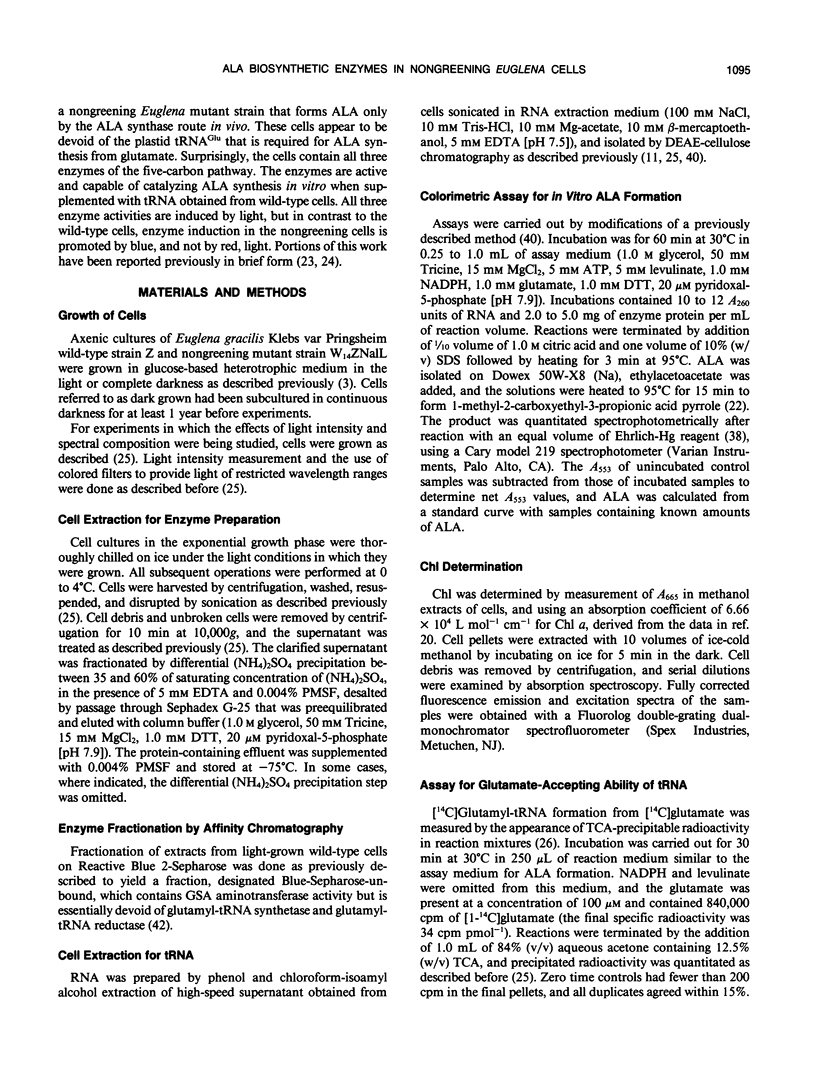
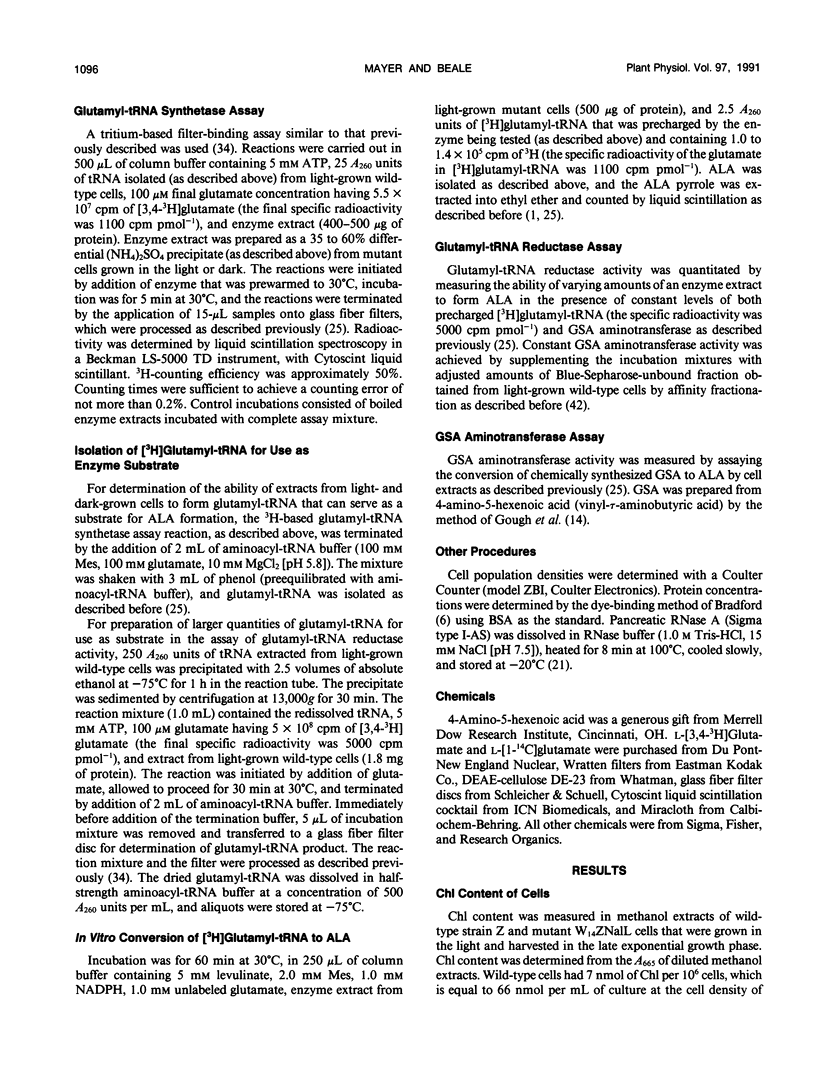
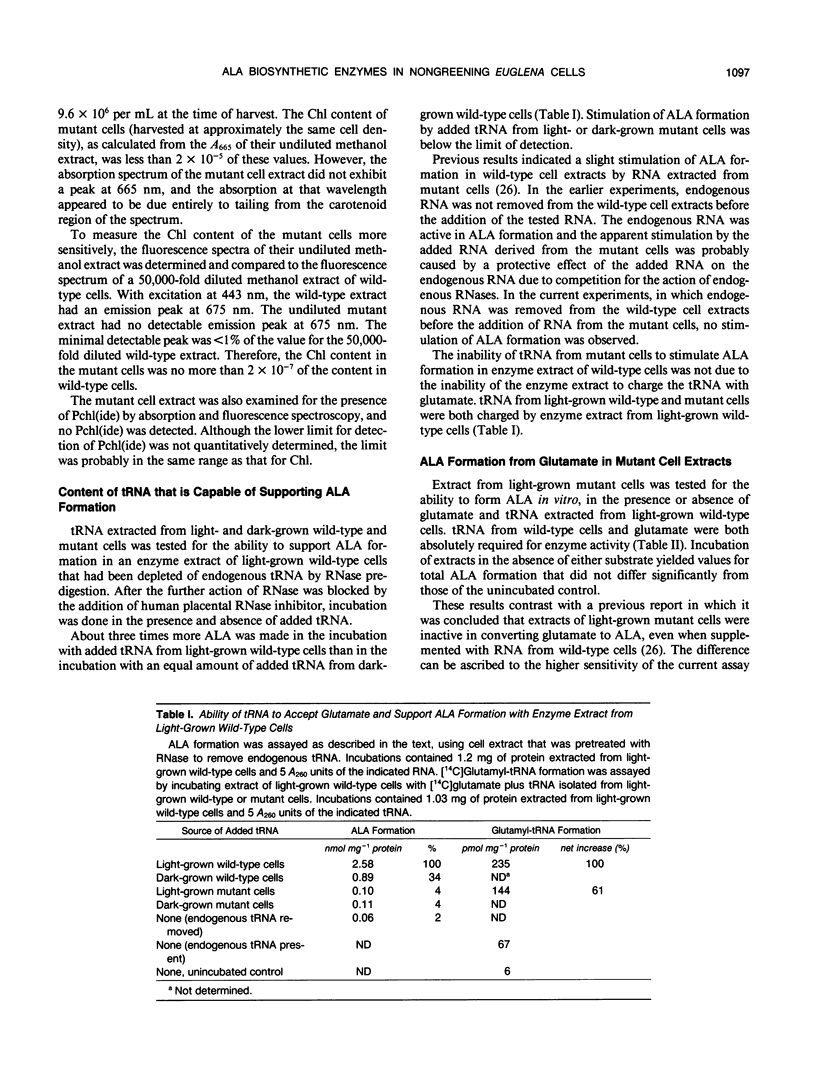
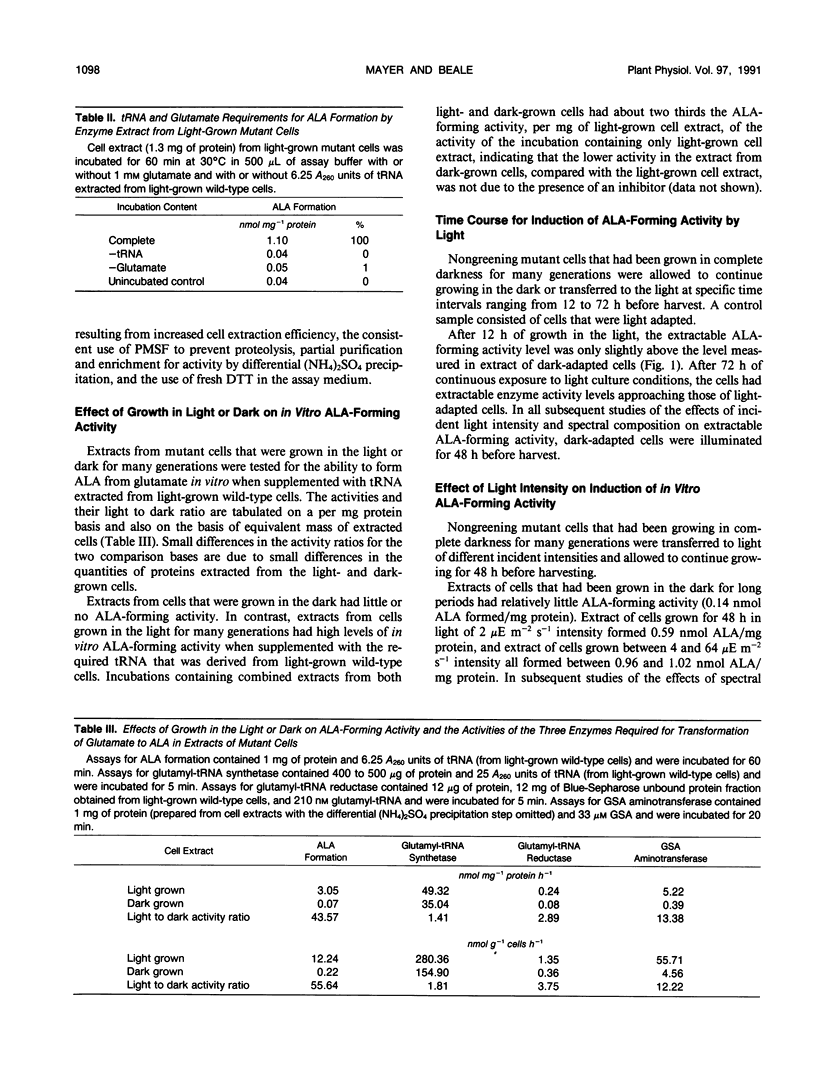
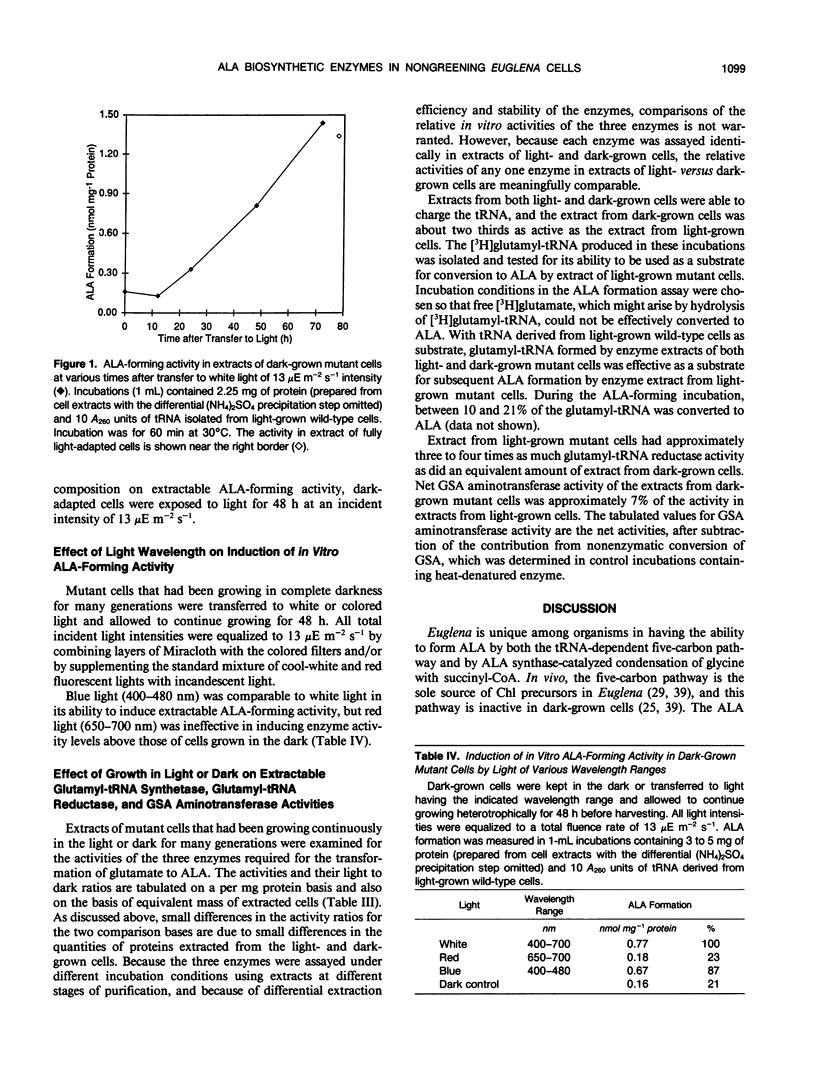
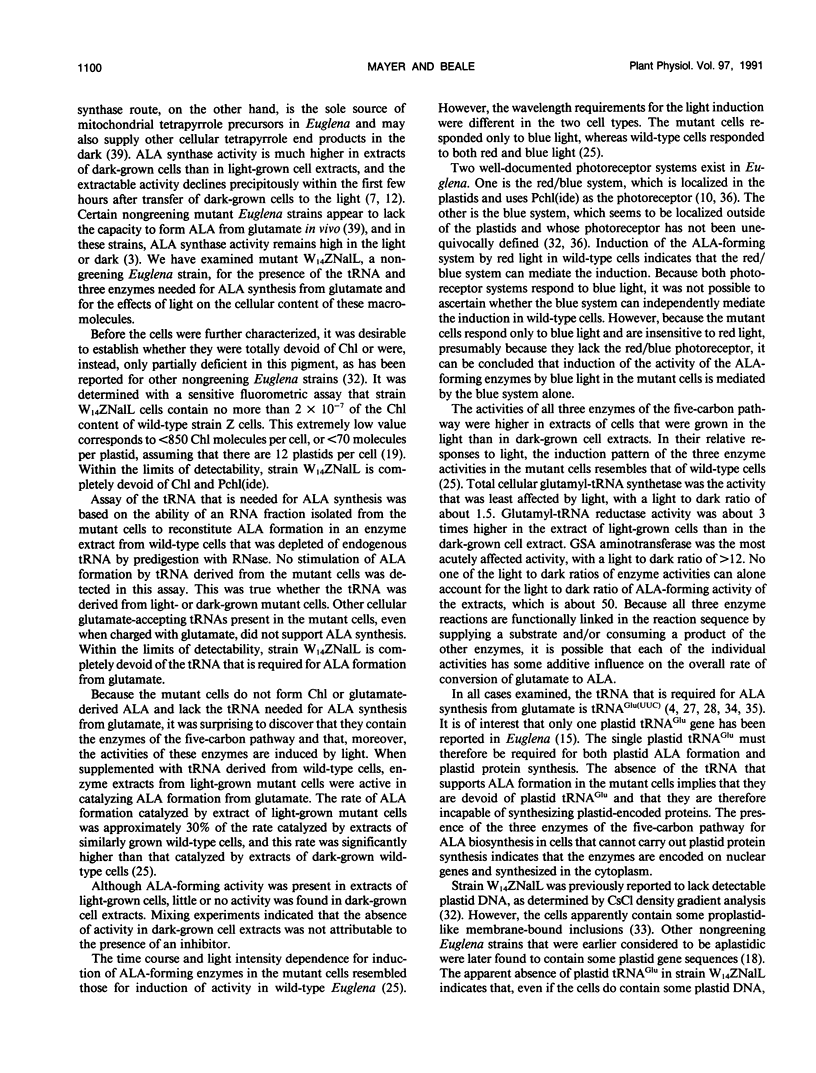
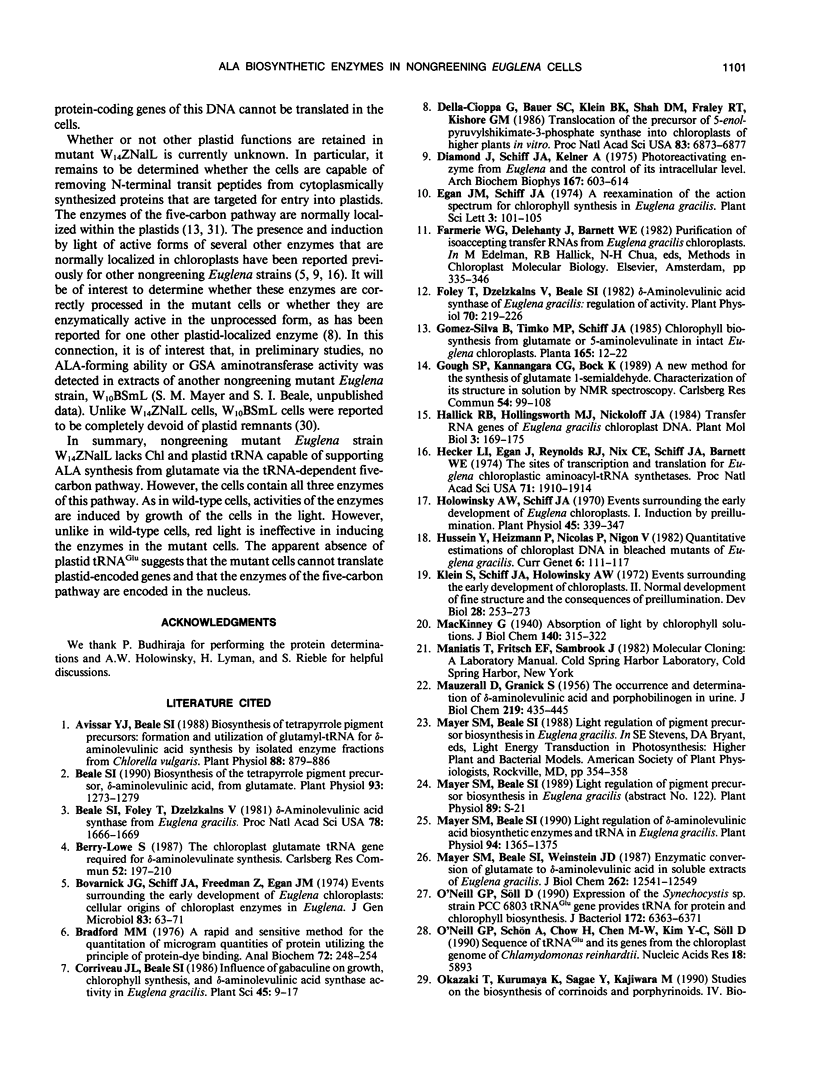
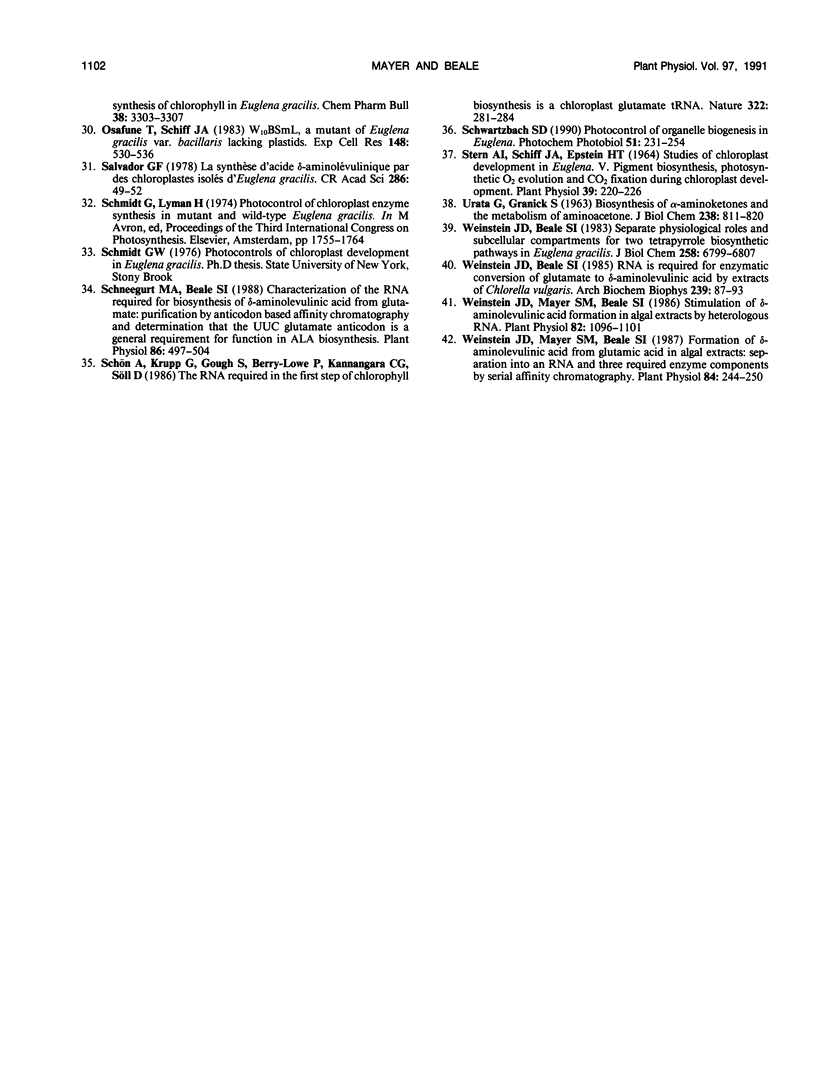
Selected References
These references are in PubMed. This may not be the complete list of references from this article.
- Avissar Y. J., Beale S. I. Biosynthesis of Tetrapyrrole Pigment Precursors : Formation and Utilization of Glutamyl-tRNA for delta-Aminolevulinic Acid Synthesis by Isolated Enzyme Fractions from Chlorella Vulgaris. Plant Physiol. 1988 Nov;88(3):879–886. doi: 10.1104/pp.88.3.879. [DOI] [PMC free article] [PubMed] [Google Scholar]
- Beale S. I. Biosynthesis of the Tetrapyrrole Pigment Precursor, delta-Aminolevulinic Acid, from Glutamate. Plant Physiol. 1990 Aug;93(4):1273–1279. doi: 10.1104/pp.93.4.1273. [DOI] [PMC free article] [PubMed] [Google Scholar]
- Beale S. I., Foley T., Dzelzkalns V. delta-Aminolevulinic acid synthase from Euglena gracilis. Proc Natl Acad Sci U S A. 1981 Mar;78(3):1666–1669. doi: 10.1073/pnas.78.3.1666. [DOI] [PMC free article] [PubMed] [Google Scholar]
- Bovarnick J. G., Schiff J. A., Freedman Z., Egan J. M. Events surrounding the early development of Euglena chloroplasts: cellular origins of chloroplast enzymes in euglena. J Gen Microbiol. 1974 Jul;83(0):63–71. doi: 10.1099/00221287-83-1-63. [DOI] [PubMed] [Google Scholar]
- Bradford M. M. A rapid and sensitive method for the quantitation of microgram quantities of protein utilizing the principle of protein-dye binding. Anal Biochem. 1976 May 7;72:248–254. doi: 10.1016/0003-2697(76)90527-3. [DOI] [PubMed] [Google Scholar]
- Della-Cioppa G., Bauer S. C., Klein B. K., Shah D. M., Fraley R. T., Kishore G. M. Translocation of the precursor of 5-enolpyruvylshikimate-3-phosphate synthase into chloroplasts of higher plants in vitro. Proc Natl Acad Sci U S A. 1986 Sep;83(18):6873–6877. doi: 10.1073/pnas.83.18.6873. [DOI] [PMC free article] [PubMed] [Google Scholar]
- Diamond J., Schiff J. A., Kelner A. Photoreactivating enzyme from euglena and the control of its intracellular level. Arch Biochem Biophys. 1975 Apr;167(2):603–614. doi: 10.1016/0003-9861(75)90504-4. [DOI] [PubMed] [Google Scholar]
- Fett W. F., Dunn M. F. Exopolysaccharides Produced by Phytopathogenic Pseudomonas syringae Pathovars in Infected Leaves of Susceptible Hosts. Plant Physiol. 1989 Jan;89(1):5–9. doi: 10.1104/pp.89.1.5. [DOI] [PMC free article] [PubMed] [Google Scholar]
- Foley T., Dzelzkalns V., Beale S. I. delta-Aminolevulinic Acid Synthase of Euglena gracilis: Regulation of Activity. Plant Physiol. 1982 Jul;70(1):219–226. doi: 10.1104/pp.70.1.219. [DOI] [PMC free article] [PubMed] [Google Scholar]
- Hecker L. I., Egan J., Reynolds R. J., Nix C. E., Schiff J. A., Barnett W. E. The sites of transcription and translation for Euglena chloroplastic aminoacyl-tRNA synthetases. Proc Natl Acad Sci U S A. 1974 May;71(5):1910–1914. doi: 10.1073/pnas.71.5.1910. [DOI] [PMC free article] [PubMed] [Google Scholar]
- Holowinsky A. W., Schiff J. A. Events surrounding the early development of Euglena chloroplasts. I. Induction by preillumination. Plant Physiol. 1970 Mar;45(3):339–347. doi: 10.1104/pp.45.3.339. [DOI] [PMC free article] [PubMed] [Google Scholar]
- Klein S., Schiff J. A., Holowinsky A. W. Events surrounding the early development of Euglena chloroplasts. II. Normal development of fine structure and the consequences of preillumination. Dev Biol. 1972 May;28(1):253–273. doi: 10.1016/0012-1606(72)90142-x. [DOI] [PubMed] [Google Scholar]
- MAUZERALL D., GRANICK S. The occurrence and determination of delta-amino-levulinic acid and porphobilinogen in urine. J Biol Chem. 1956 Mar;219(1):435–446. [PubMed] [Google Scholar]
- Mayer S. M., Beale S. I. Light Regulation of delta-Aminolevulinic Acid Biosynthetic Enzymes and tRNA in Euglena gracilis. Plant Physiol. 1990 Nov;94(3):1365–1375. doi: 10.1104/pp.94.3.1365. [DOI] [PMC free article] [PubMed] [Google Scholar]
- Mayer S. M., Beale S. I., Weinstein J. D. Enzymatic conversion of glutamate to delta-aminolevulinic acid in soluble extracts of Euglena gracilis. J Biol Chem. 1987 Sep 15;262(26):12541–12549. [PubMed] [Google Scholar]
- O'Neill G. P., Schön A., Chow H., Chen M. W., Kim Y. C., Söll D. Sequence of tRNA(Glu) and its genes from the chloroplast genome of Chlamydomonas reinhardtii. Nucleic Acids Res. 1990 Oct 11;18(19):5893–5893. doi: 10.1093/nar/18.19.5893. [DOI] [PMC free article] [PubMed] [Google Scholar]
- O'Neill G. P., Söll D. Expression of the Synechocystis sp. strain PCC 6803 tRNA(Glu) gene provides tRNA for protein and chlorophyll biosynthesis. J Bacteriol. 1990 Nov;172(11):6363–6371. doi: 10.1128/jb.172.11.6363-6371.1990. [DOI] [PMC free article] [PubMed] [Google Scholar]
- Osafune T., Schiff J. A. W10BSmL, a mutant of Euglena gracilis var. bacillaris lacking plastids. Exp Cell Res. 1983 Oct 15;148(2):530–535. doi: 10.1016/0014-4827(83)90176-3. [DOI] [PubMed] [Google Scholar]
- Schneegurt M. A., Beale S. I. Characterization of the RNA Required for Biosynthesis of delta-Aminolevulinic Acid from Glutamate : Purification by Anticodon-Based Affinity Chromatography and Determination That the UUC Glutamate Anticodon Is a General Requirement for Function in ALA Biosynthesis. Plant Physiol. 1988 Feb;86(2):497–504. doi: 10.1104/pp.86.2.497. [DOI] [PMC free article] [PubMed] [Google Scholar]
- Stern A. I., Schiff J. A., Epstein H. T. Studies of Chloroplast Development in Euglena. V. Pigment Biosynthesis, Photosynthetic Oxygen Evolution and Carbon Dioxide Fixation during Chloroplast Development. Plant Physiol. 1964 Mar;39(2):220–226. doi: 10.1104/pp.39.2.220. [DOI] [PMC free article] [PubMed] [Google Scholar]
- URATA G., GRANICK S. Biosynthesis of alpha-aminoketones and the metabolism of aminoacetone. J Biol Chem. 1963 Feb;238:811–820. [PubMed] [Google Scholar]
- Weinstein J. D., Beale S. I. RNA is required for enzymatic conversion of glutamate to delta-aminolevulinate by extracts of Chlorella vulgaris. Arch Biochem Biophys. 1985 May 15;239(1):87–93. doi: 10.1016/0003-9861(85)90814-8. [DOI] [PubMed] [Google Scholar]
- Weinstein J. D., Beale S. I. Separate physiological roles and subcellular compartments for two tetrapyrrole biosynthetic pathways in Euglena gracilis. J Biol Chem. 1983 Jun 10;258(11):6799–6807. [PubMed] [Google Scholar]
- Weinstein J. D., Mayer S. M., Beale S. I. Formation of delta-Aminolevulinic Acid from Glutamic Acid in Algal Extracts : Separation into an RNA and Three Required Enzyme Components by Serial Affinity Chromatography. Plant Physiol. 1987 Jun;84(2):244–250. doi: 10.1104/pp.84.2.244. [DOI] [PMC free article] [PubMed] [Google Scholar]
- Weinstein J. D., Mayer S. M., Beale S. I. Stimulation of delta-Aminolevulinic Acid Formation in Algal Extracts by Heterologous RNA. Plant Physiol. 1986 Dec;82(4):1096–1101. doi: 10.1104/pp.82.4.1096. [DOI] [PMC free article] [PubMed] [Google Scholar]


